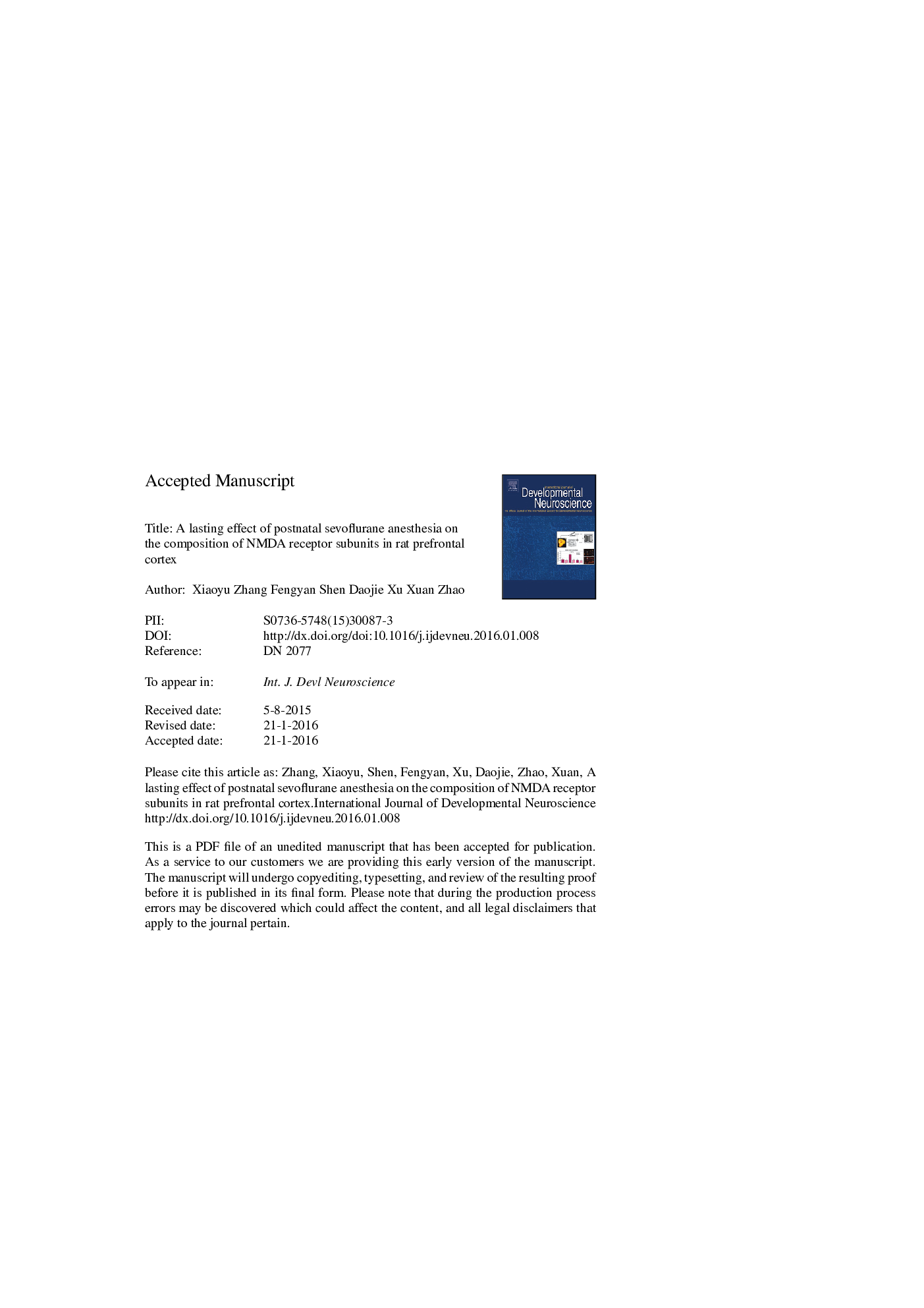| کد مقاله | کد نشریه | سال انتشار | مقاله انگلیسی | نسخه تمام متن |
|---|---|---|---|---|
| 8626225 | 1568376 | 2016 | 27 صفحه PDF | دانلود رایگان |
عنوان انگلیسی مقاله ISI
A lasting effect of postnatal sevoflurane anesthesia on the composition of NMDA receptor subunits in rat prefrontal cortex
دانلود مقاله + سفارش ترجمه
دانلود مقاله ISI انگلیسی
رایگان برای ایرانیان
کلمات کلیدی
PFCPNDN-methyl-d-aspartateNMDAAMPASABSevoflurane - سووفلورانNMDA receptor - NMDA گیرندهγ-aminobutyric acid type A - γ-آمینوآبتیریک اسید نوع Aα-amino-3-hydroxy-5-methyl-4-isoxazolepropionic acid - اسید α-آمینو 3-هیدروکسی-5-متیل-4-ایزوکسول پپونیکgamma-aminobutyric acid - اسید گاما آمینو بوتیریکADHD - بیشفعالیPediatric anesthesia - بیهوشی کودکانlong term potentiation - تقویت طولانی مدتLTP - تقویت طولانی مدت یا LTP CNS - دستگاه عصبی مرکزیspontaneous alternation behavior - رفتار متناوب خودانگیختهpostnatal day - روز پس از زایمانcentral nervous system - سیستم عصبی مرکزیprefrontal cortex - قشر prefrontalAttention deficit/hyperactivity disorder - کمبود توجه / اختلال بیش فعالیGABAA - گاباGABA - گاباcontrol group - گروه کنترل
موضوعات مرتبط
علوم زیستی و بیوفناوری
بیوشیمی، ژنتیک و زیست شناسی مولکولی
زیست شناسی تکاملی
پیش نمایش صفحه اول مقاله

چکیده انگلیسی
Sevoflurane is widely used in pediatric anesthesia and studies have shown that it is capable of inducing neurodegeneration and subsequent cognitive disorders in the developing brain. However, the evidence that anesthetics are toxic to the human brain is insufficient. N-Methyl-d-aspartate (NMDA) receptors, critical for learning and memory, display expression changes with age and can be modulated by inhalation anesthetics. Generally, NMDA receptor (NR) type 1 is expressed at birth, peaks around the third postnatal week, and then declines slightly to adult levels. NR2Bs slowly decrease and NR2As gradually increase during postnatal development. These developmental switches of NMDA receptor subunits composition mark the transition from immature to adult neural processing and allow for the final maturation of associative learning abilities. In this study, we aimed to evaluate the effect of repeated sevoflurane anesthesia on NMDA receptor subunits composition in the developing rat brain and related behavioral disorders. Six-day-old male Sprague Dawley rats were randomly allocated into either a control group (group con) or a sevoflurane group (group sevo). Group sevo inhaled 2.1% sevoflurane carried by 70% oxygen for 2Â h each day from postnatal day (PND) 6 to PND 8. The same procedure, without applying the sevoflurane, was executed in group con. The membrane protein expression of NR1, NR2A and NR2B in the prefrontal cortex (PFC) and hippocampus was assessed at the end of the three days of anesthesia and at PND 21. An open field test was carried out to assess spontaneous locomotion on PNDs 21, 28 and 35. Y maze performance was used to assess attention and working memory on PND 28. Sevoflurane induced upregulation of NR1 and NR2B in the PFC at the end of anesthesia. On PND 21, NR1 and NR2B receptors were significantly increased whereas NR2A receptors were significantly decreased in the PFC in group sevo. Sevoflurane-treated rats showed hyper-locomotion and impairment of working memory in the behavior tests. These results indicate that repeated sevoflurane anesthesia at early stage of life can induce a long lasting effect of interfering with NMDA receptor subunits composition in rat PFC. These changes may contribute to the effects of sevoflurane on neuronal development and subsequent neurobehavioral disorders.
ناشر
Database: Elsevier - ScienceDirect (ساینس دایرکت)
Journal: International Journal of Developmental Neuroscience - Volume 54, November 2016, Pages 62-69
Journal: International Journal of Developmental Neuroscience - Volume 54, November 2016, Pages 62-69
نویسندگان
Xiaoyu Zhang, Fengyan Shen, Daojie Xu, Xuan Zhao,